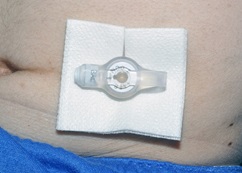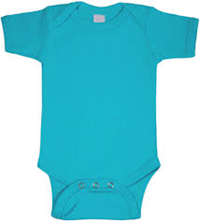In this section
Chapter 2: Daily care
What to expect after the feeding tube is put in
Pain
After surgery, you can expect your child to have some pain. The first couple days, the site is most tender. Tylenol or Motrin usually work for most children. If your child is uncomfortable and you think they need something stronger, tell your nurse.
You may give your child pain medicine on a schedule for the first couple days. Then you can start to give the medicine less often. The pain will get better each day.
Activity
Most children are able to get out of bed, sit in a chair, or walk the day of their tube surgery. You can expect your child to be back to their usual self after about 2 weeks.
Most babies can be held the day of their tube surgery. Tummy time depends on how they handle it. This is usually about 2 weeks after the tube is placed.
Older children can be active, run around, play, swim or take part in sports with a tube.
Drainage
Some mild bleeding at the site is common in the beginning. As the site is healing it is normal to have it crust and drain. This can last several weeks.
Redness
As the skin is healing from surgery, the site can have a little bit of redness or irritation. You will learn how to care for redness at home. To watch a video, visit our video page >>
Tube and skin care
It helps to have a daily routine to care for your child's tube and to check the skin around the tube. Bath time is a good time to do these cares.
It is important to do good site cares and keep the tube secure while the tract is healing for the first 6 to 12 weeks.
Check and clean the skin around the tube every day, or more often if needed. Look at the site to make sure it looks healthy.
It is best to have a site that is clean and dry with a secure tube.
Cleaning the skin
Steps
 Get your supplies.
Get your supplies.
– Wash cloth or cotton-tipped swabs
– Mild soap and water- Wash your hands with soap and water.
- Remove any dressing.
- Use cotton-tipped swabs or a washcloth. Wet them with soap and water to clean the skin around the tube. It is important to clean around and under the tube. Try to get all the drainage off the skin.
- Rinse the soap off.
- Dry the area around the tube.
- Spin the tube in the tract every day with site cares. This stops the skin from sticking to the tube.
When not to spin the tube:
- If your child has a GJ-tube. This will cause the tube to twist which can change the position of the tube on the inside.
- If your child has stitches on the tube. Wait until the stitches are removed.
Other information
Do not use any creams or powders on the skin unless you are told to do so.
If you notice that the skin around the tube has crusty dried drainage, try this:
- Soak gauze or a washcloth with warm water. Put around tube to loosen crusty drainage. Leave on the skin for 5 to 20 minutes.
- Gently wipe to remove drainage.
- Removing the drainage will help the skin heal properly around the tube.
Bathing and swimming
Your child can shower 2 days after the tube is put in.
Your child can start taking baths 1 week after the tube is put in.
Your child can go swimming 1 month after the tube is put in.
Dressings
A dressing is used when there is drainage. If there is no drainage at the site, then it is best to leave the site open to air.
A 2 inch by 2 inch split gauze can be used at the site. Only use piece of split gauze at the site. You can use the pre-cut gauze if you have it or you can make your own.
Change the dressing every day when cleaning the skin. If the dressing is dirty, you may need to change the dressing more often.
Securing the tube
It is very important to keep the tube secure, especially while the site is healing. The tube should not lean or pull at the site. If you find the tube leaning or pulling often, then you may need to find a different way to secure the tube.
If your child is active, you will need to be creative and very careful to make sure the tube is secure at all times. Keeping the tube secure will help keep the tube from being accidentally pulled out. There are many ways to secure a tube.
Tension loop
 A tension loop should be used with long tubes (pictured top right). It should also be used if a child is vented or fed continuously. A secure tube will help keep the stoma site healthy.
A tension loop should be used with long tubes (pictured top right). It should also be used if a child is vented or fed continuously. A secure tube will help keep the stoma site healthy.
A tension loop can help:
- keep the tube secure
- stop the tube from being accidentally pulled out
- stop the tube from wiggling at the site
Change the tension loop if:
- the tube is leaning
- if the tension loop fell off
- if it has been in the same spot on the belly for 3 days
How to make a tension loop
- Get your supplies.
– 1 x 4-inch piece of tape. It is okay to use a smaller piece of tape on a baby. - Put tape over tube near site.
- Wrap tape around tube until the tape meets.
- Pinch the tape together where it meets.
- Put the ends of the tape and stick on the skin.
It is best to put the tension loop about an inch from the stoma site. There will be less slack and less wiggling this way.
 Bolster to secure long tubes
Bolster to secure long tubes
This is used for long tubes without a bar or disc to hold it secure. Bolsters are most often used for Pezzer tubes or Foley tubes.
To learn more about bolsters:
- See References: How to make a bolster
- Children's G-tube videos page
- Read teaching sheet on bolsters or ask your child’s nurse.
Other ways to secure all types of tubes
 Ideas to protect the tube for active children.
Ideas to protect the tube for active children.
- Elastic binder or a belly band. (pictured right)
- An adult stretch headband or top.
- One-piece undershirt, sleeper or long t-shirt tucked into the pants. (pictured left)
- Run tubing through clothing and out the leg of the pants. This makes it harder for a child to reach.
Key points
- Keep the site clean.
- Keep the site dry.
- Keep the tube secure.
All three items helps keep the site healthy.



